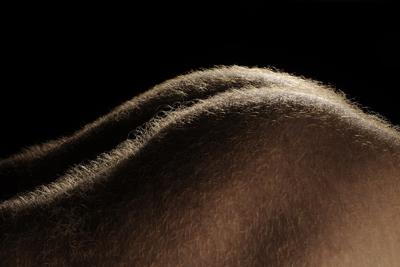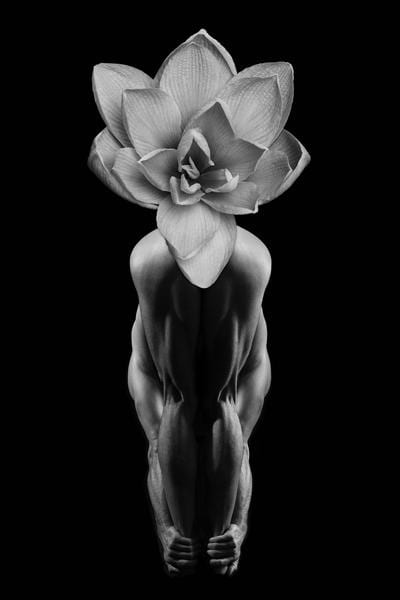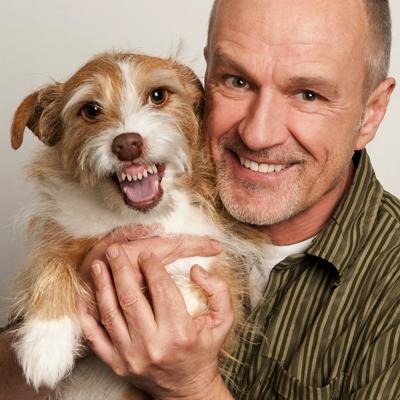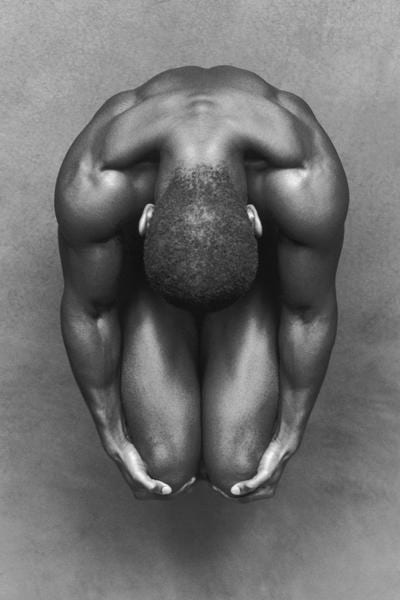
New Tranformations physique photo called "Monts et merveilles" Credit: Robert Laliberté

New Tranformations physique photo called "Fleur male" Credit: Robert Laliberté

A self-portrait, Laliberté and his dog Foto Credit: Robert Laliberté
In May of 1984, two days after a soldier killed three people and wounded 13 others in the Quebec National Assembly chamber in protest of the government of then-premier René Lévesque, Montreal photographer Robert Laliberté found himself shooting Lévesque, with his camera.
“I’d been commissioned to photograph Lévesque and he was edgy,” Laliberté recalls. “But I was just starting my career and so I was very, very nervous, too. It hit me then that with all the trouble that was happening, he was really quite nice to me. He was patient with me. Then, a month before he died in 1987, I photographed him again.”
The photos of Lévesque would not bring Laliberté notoriety. Fame would come instead from his well-known shots of the male physique. Many of these photos will be on display at Laliberté’s all-new solo photo exhibition, Tranformations, which opens in Montreal on Tuesday, July 12.
“When I was young, in the 1970s, I travelled to San Francisco and discovered a book about the late photographer Diane Arbus,” Laliberté says. “I realized then what I wanted to do and immediately enrolled in photo school in Montreal. The physique thing came about accidentally when [former Fugues magazine publisher] Martin Hamel took over in 1984 and asked me to photograph young men for his covers. So I agreed, in exchange for ads for my studio. In Montreal at that time, go-go dancers were starting in gay bars. So I did over 150 Fugues covers for 12 years. I never missed one issue.”
As a result, Laliberté adds, “Models started calling me.” He would go on to become the art director for Priape, shoot many campaigns for Cruiseline, and show 14 group and 20 solo exhibitions in art galleries around the world. In addition to Lévesque, the long list of celebrities photographed by Laliberté over his career includes Robert Lepage, Michel Tremblay and Phyllis Lambert. Laliberté even photographed this reporter twice, once in a 1993 Divers/Cité group cover photo for Fugues, and once in a 2009 headshot for my column in that magazine.
“Over the last two decades of the 20th century, Robert Laliberté has become the leading photographer of Montreal’s gay community,” Marcel F Raymond, of the Archives Gaies du Québec, once observed. “Through his body of work he has made a significant contribution to Montreal gay culture.”
Laliberté says modestly, “With the boys, I have seen it all, including some stories I won’t tell you about. But I have gotten all kinds of requests over the years. Because I do nudes, people think I will do anything, but I won’t photograph people having sex with animals or beating children.
“The real reason I photograph nude models is not because I want to show nudity, but rather I want the photos to be timeless. Clothing sets the time period. Nudity takes away the time frame. Plus, we are born naked and we die naked.”
Transformations comprises 70 new photos in 20 series. Among them are two photographs of nude elderly people.
“Commercially they are not big sellers, and I have to make a living,” Laliberté, now 60 years old, explains. “I’ve accepted commissions from older people. Then I decided it was time to test the waters. There will be two shots of old people. It’s a different aesthetic, so I don’t know how people will react to it. We’ll see.”
Laliberté also embraces the newfound freedom of digital photography.
“Taking pictures used to be very expensive – all that film, the prints you had to develop in the dark room, hoping for a few good shots. But digital photography has levelled the playing field. Now everybody can afford to take pictures. Anyone can take a picture with their iPhone.”
Says Laliberté, “I like the digital world. I wouldn’t go back to what it was. Anybody can be a photographer. But not everybody has an eye and not everybody is an artist. When I started my career, I was more of a photographer. Now I consider myself more of an artist.”


 Why you can trust Xtra
Why you can trust Xtra


